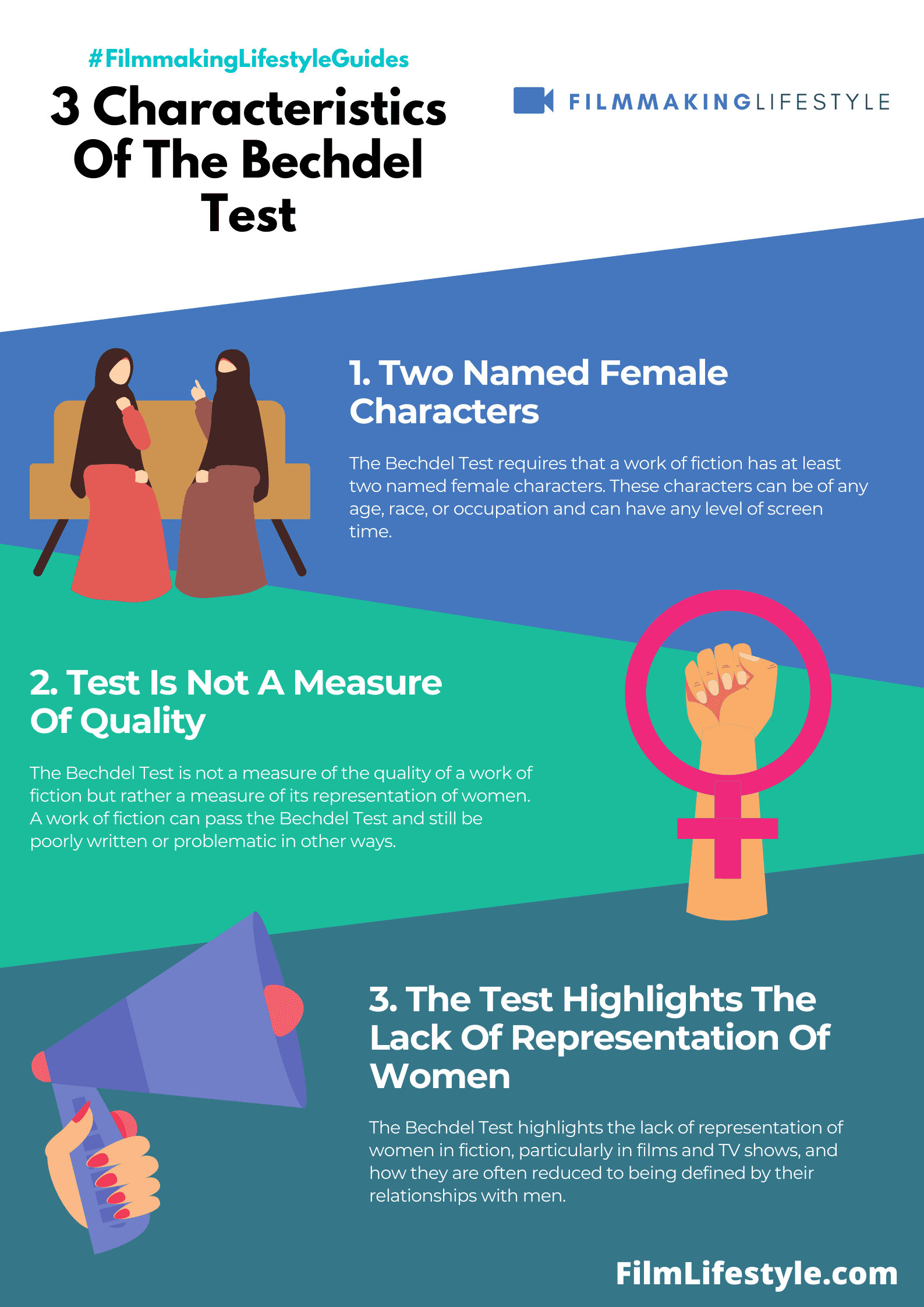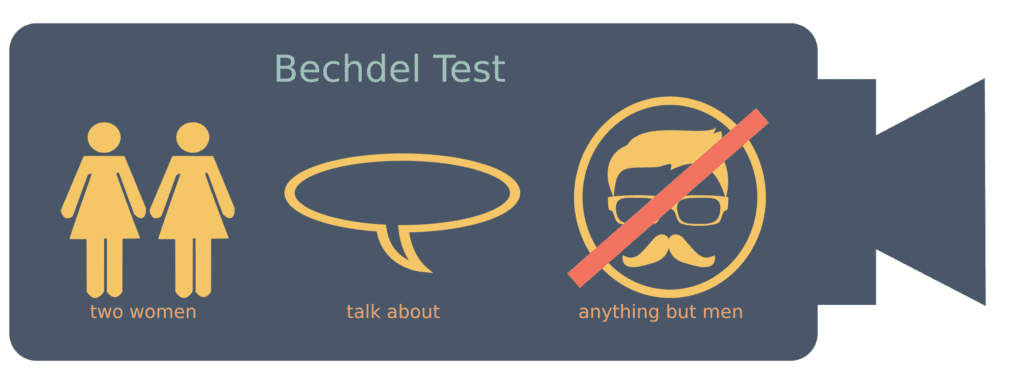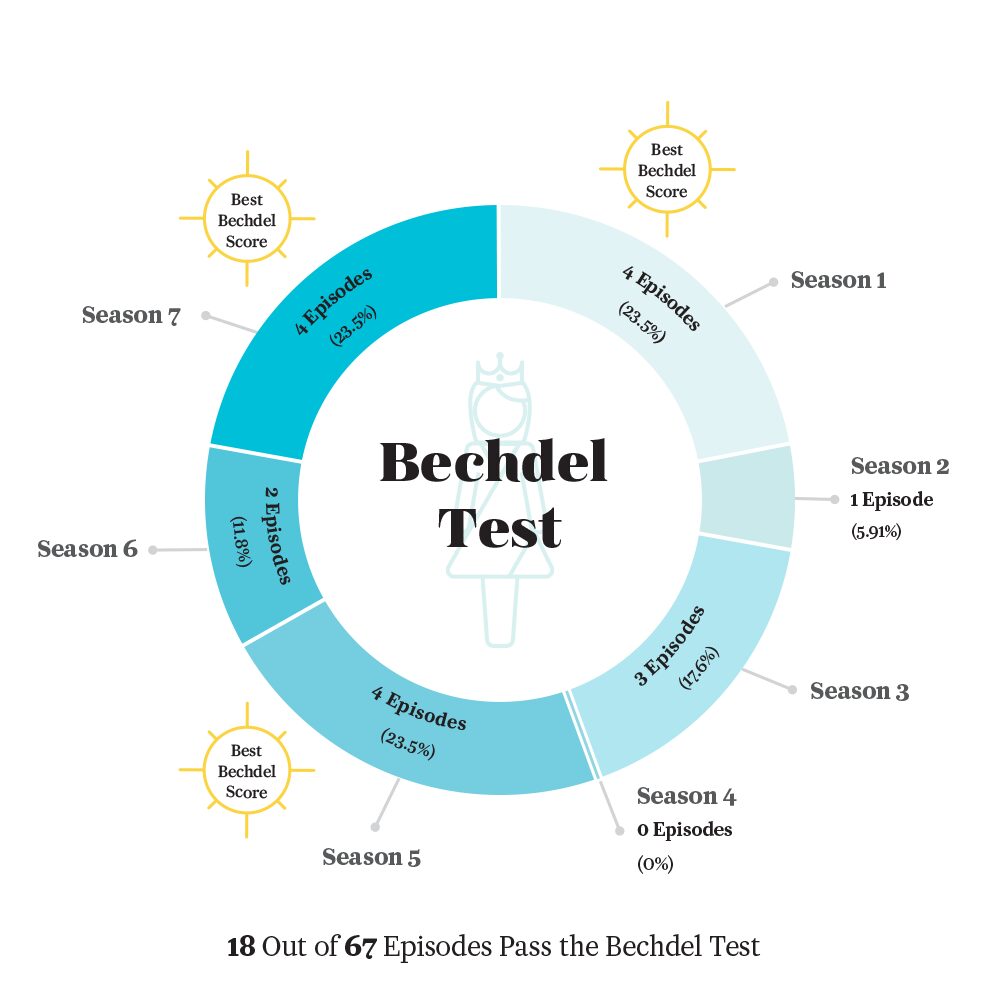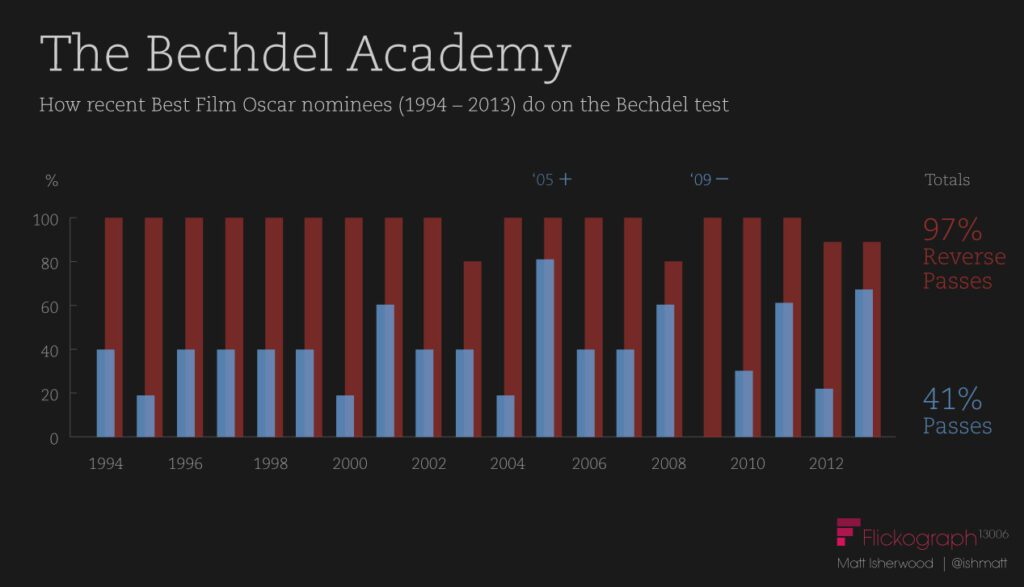The Bechdel Test is a test that asks if two named female characters talk to each other about something other than a man.
It was created by Alison Bechdel in 1985, and it has been used as an indicator of how women are portrayed in movies.
This blog post will discuss the history of the test, why it matters now more than ever before, and some Hollywood films that pass the test.
WHAT IS THE BECHDEL TEST
What Is the Bechdel Test?
The Bechdel Test is a low-barrier way to evaluate the representation of women in film.
The test was created by Alison Bechdel and her friend Liz Wallace in 1985.
Here are 3 rules for this test:
1. It has to have at least two (named) female characters;
2. who talk to each other about something besides a man, and
3. who both appear on screen together for more than one minute.
Ever wondered how to gauge female representation in film?
The Bechdel Test is a simple way to measure the presence of women on screen.
It’s not just about quantity; it’s about quality.
We’ll explore how this test challenges the norms of character development and plot dynamics.
Stay with us as we jump into the Bechdel Test, revealing its criteria and why it’s become a critical lens for feminist critique in cinema.
Bechdel Test Defined
The Bechdel Test, originally conceived by Alison Bechdel in her 1985 comic strip Dykes to Watch Out For, is a measure of representation of women in film.
It poses three simple criteria that serve as a litmus test for female presence on screen.
First, the film must have at least two women characters.
These characters need to have their own narrative importance, not merely serving as backdrops to the male leads.
They should be well-rounded personalities with significance to the story’s progression.
Second, these women must converse with each other at some point.
Their interaction should revolve around topics other than men, highlighting that women’s lives are not centered solely around their relationships with the opposite sex.
finally, the two women should have names.
This underscores the value of their identity within the narrative, ensuring they are not defined by their relationships but rather recognized as individuals.
We often use this set of rules to quickly gauge a movie’s commitment to creating multi-dimensional female characters:
- There must be at least two named women in the film,
- These characters must talk to each other,
- Their conversation must be about something other than a man.
While simple, the Bechdel Test has profound implications.
It reveals systemic issues in storytelling and character creation.
It’s not just a benchmark but also a spotlight on the skewed depiction of women in cinema, encouraging filmmakers to craft richer, more diverse narratives.
In observing these criteria, we notice patterns in film.
We recognize that not every movie that passes the Bechdel Test necessarily offers a nuanced portrayal of women.
Similarly, not all films that fail the test are blatantly dismissive of female roles.
But, the consistency in results across genres and eras reveals a larger trend in the need for better representation.
The Origins Of The Bechdel Test
The concept of the Bechdel Test first emerged from the comic strip Dykes to Watch Out For.
Created by Alison Bechdel in 1985, the test was introduced as part of a casual conversation between characters.
Though initially meant as a lighthearted commentary, the test quickly became a serious tool for examining gender bias in cinema.
Alison Bechdel credit’s the idea to her friend Liz Wallace and draws inspiration from the works of Virginia Woolf.
Specifically, Woolf’s essay A Room of One’s Own emphasized the absence of women’s autonomy in literature and the arts.
This became a cornerstone for the Bechdel Test’s future significance.
Impact of the Bechdel Test burgeoned as feminists and film critics adopted it as a benchmark.
They evaluated films bearing in mind that representation goes beyond mere inclusion.
The simplicity of the Test’s criteria belies the complex conversations it sparks about women’s roles in storytelling and societal perceptions at large.

Over time, the Bechdel Test has garnered attention in academic circles and industry discussions.
It’s not just a litmus test for assessing female representation in individual films but a cultural barometer reflecting broader issues in film production and narrative priorities.
Our focus on film narratives is not to discredit the significance of photography in capturing female experiences.
Instead it’s to illuminate the systemic storytelling choices made in cinematic works.
Recognition of the Bechdel Test’s origins is crucial for understanding its role in ongoing conversations about gender in both independent and mainstream media.
The Three Criteria Of The Test
We often refer to the Bechdel Test as a simple measure of female presence in film.
It revolves around three specific criteria that a movie must meet to pass the test.
The first criterion insists that the film must have at least two named female characters.
These characters form the backbone of the second requirement – these women must talk to each other at some point during the movie.
Finally, their conversation must be about something other than a man.
This third point is crucial in assessing whether the film portrays women as independent entities with concerns beyond romantic interests.
It’s important to understand what meeting these criteria means:
- The presence of named female characters avoids reducing women to background props or anonymous figures.
- By having women who converse, the film potentially gives space to female perspectives.
- The content of the conversation sheds light on the autonomy of female characters and their depth in the storyline.
Films like Gravity and The Hunger Games pass the Bechdel Test by not just ticking these boxes but by integrating complex female characters that drive the narrative.
We must note, But, that passing the Bechdel Test does not necessarily certify a film as feminist or inclusive.
It’s a starting point for analyzing female representation, but it doesn’t account for the quality of the dialogue or the significance of the female characters’ roles.
Conversely, a film could fail the Bechdel Test while still presenting powerful and well-developed female leads.
The test primarily opens a dialogue about gender portrayal but is not an ultimate indicator of a film’s overall commitment to gender equality.
We explore how the bare minimum established by the Bechdel Test is a useful tool, but one that must be complemented by a deeper analysis of character agency and narrative importance.
Films are multifaceted, and their assessment through the Bechdel Test is just one of the many lenses we can use to gauge the nuances of female representation.
The Significance Of Passing The Bechdel Test
The Bechdel Test sets a minimal benchmark for the presence of female characters in cinema.
When a film passes this test, it’s a step toward rectifying gender disparities on screen.
Films that meet the Bechdel Test criteria are advancing more nuanced woman-led narratives.
This achievement signals an industry move towards gender equality, both in character representation and storytelling dynamics.
Even though the simplicity of the test, its implications are profound.
Films like Mad Max: Fury Road and The Hunger Games series demonstrate that strong female characters can drive a plot just as effectively as their male counterparts.
Passing the Bechdel Test can also affect a film’s financial performance.
Studies show that films passing the Test tend to have a better return on investment.
- Films that pass the Bechdel Test may attract a wider audience.
- Female viewers often seek films with relatable, multidimensional female characters.
Achieving the Bechdel Test’s requirements often results in more empowered female roles.
It’s a step towards breaking common stereotypes and changing the societal narrative on gender roles.
Films which pass the Bechdel Test are not just checking a box.
They are contributing to a larger conversation about representation and inclusion in media.
Criticisms And Controversies Surrounding The Bechdel Test
Even though its popularity, the Bechdel Test has faced various criticisms.
Simplicity is a double-edged sword – while it allows for straightforward assessment of films, it also oversimplifies complex issues.
Critics argue that there’s a risk of reducing female representation to a checklist that ignores the quality or depth of the characters’ narratives.
Another common critique involves the misinterpretation of the test’s purpose.
Initially a tool for raising awareness, some perceive achieving a Bechdel pass as an end goal, conferring a misleading stamp of “feminist approval” on films that may have other representations issues.
For instance, even if a film like Jurassic Park passes the test, it doesn’t necessarily mean it champions gender equality.
Considerable debate also exists over the Bechdel Test’s applicability across genres and cultures.
Genres such as action or historical dramas may have less female presence due to genre conventions or historical accuracy.
- Mad Max: Fury Road is praised for strong female characters but doesn’t comfortably pass.
- Interstellar, rich with complex themes, is likewise critiqued About its female characters Even though passing the test.
also, cross-cultural differences in storytelling raise questions about the Bechdel Test’s universal relevance.
Non-Western films may focus on themes or social norms that don’t align with the test’s criteria, leading to skewed assessments when judging these narratives through a Western-centric lens.
Industry professionals have also questioned whether the Bechdel Test’s pass or fail status incentivizes superficial changes to scripts.
Some producers may add irrelevant scenes to secure a pass, hence missing the point of promoting the authentic inclusion of women in film.
The evolving discussion surrounding the Bechdel Test highlights an ongoing journey toward authentic representation.
As we explore new ways to evaluate and champion female voices in filmmaking, the conversation expands beyond checkboxes to embrace the unique stories women have to tell.
What Is The Bechdel Test – Wrap Up
We’ve explored the intricacies of the Bechdel Test and its role in critiquing female presence in film.
Even though its limitations and the debates it sparks, the test remains a valuable conversation starter about gender representation in media.
It’s clear that the journey to more nuanced and authentic portrayals of women on screen is ongoing.
We must continue to challenge and refine our criteria for representation, ensuring that the stories we celebrate on screen mirror the rich diversity of experiences in the real world.
Let’s keep pushing the boundaries and advocating for stories that give women the depth and complexity they deserve.
Frequently Asked Questions
What Is The Bechdel Test?
The Bechdel Test is a simple measure to evaluate the representation of women in film, requiring that a movie features at least two women who talk to each other about something other than a man.
Why Do Some Critics Oppose The Bechdel Test?
Some critics argue that the test oversimplifies female representation by reducing it to a checklist, which doesn’t necessarily ensure the portrayal of complex, authentic female characters or narratives.
Can The Bechdel Test Be Applied To All Film Genres?
The applicability of the Bechdel Test varies across genres; not all genres may prioritize or naturally include the discussions between female characters that the test requires.
Does The Bechdel Test Encourage Tokenistic Changes To Scripts?
There are concerns that the Bechdel Test may incentivize superficial script changes, adding scenes that meet the criteria without genuinely improving the representation of female characters.
How Does The Discourse On The Bechdel Test Reflect The Journey Towards Better Female Representation?
The ongoing debate over the Bechdel Test demonstrates the film industry’s and audiences’ evolving perspectives on the necessity of authentic female representation and the complexity of women’s stories.




Matt Crawford
Related posts
6 Comments
Leave a Reply Cancel reply
This site uses Akismet to reduce spam. Learn how your comment data is processed.



Covers everything on the Bechdel Test!
That’s what we aimed to do, Edna. Thanks.
Great ideas on the Bechdel Test. thanks
Thanks for the comment, George.
Awesome info, thanks
Cheers, Daniel.